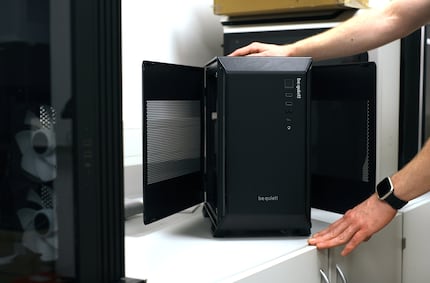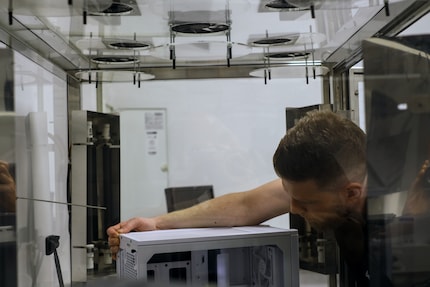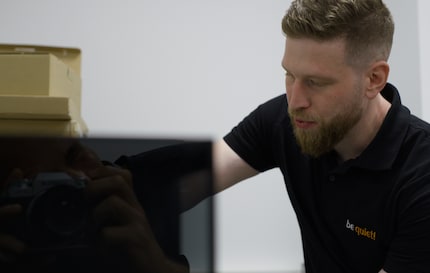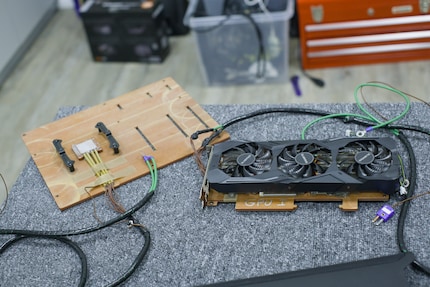
Background information
Playing "Pompeii: The Legacy": lots of "Anno", little new
by Debora Pape

PC component manufacturer Be Quiet in Glinde, northern Germany, produces PC cases that have long been more than just simple metal boxes. A visit gives an insight into the complex development of modern computer cases - from the idea to the finished product.
The journey to Glinde near Hamburg takes me down an inconspicuous industrial street. Here, just a few kilometres east of the Hanseatic city, Be Quiet - «be quiet!» in its own spelling - has its headquarters. I'm here to take a look behind the scenes of case development - with Marco Marquardt, Head of Business Unit for PC cases.
Marco shows me his office first. There are various PC cases here. Some of them I recognise from tests, others are completely new to me. «This one here», says Marco and points to one of the smaller cases, «is a one-off.» The case never made it into series production. I want to know from Marco whether it's tragic when something like this happens. «No. It's better to realise early on that a case won't be successful than to bring it to series production and then it doesn't sell. I don't see it as a setback, but as learning and improving.»

«It all starts with a market analysis», Marco tells me when I ask him about the first steps in the development of new PC cases. «We need to know what the market has to offer and what demand exists.» As soon as this has been clarified, we move on to the design phase. He cites the Light Base, Be Quiet's showcase PC case, as an example.
The basic shape with glass fronts was predetermined, but otherwise we had a free hand. A total of 25 designs were created during the design phase.
Marco explains to me that the process not only requires creative ideas, but also a sense of feasibility. «We sketch, create 3D models and then build a handmade sample. Every sheet of metal is folded and bent by hand - just like a prototype for a car.» Mock-ups like this are crucial for identifying potential problems at an early stage and making adjustments before the expensive moulds are created for mass production. But even such a mockup is not cheap: it can cost up to 10,000 US dollars.
The team uses this first physical model to carry out performance and compatibility tests. They often discover problems: The space for a water cooling system is too small, a cable does not fit through the intended opening. Every tiny design decision has an impact on the performance, compatibility and handling of the product.

Once a prototype meets the requirements of Marco and his team, the tooling phase follows - 90 days in which the tools are manufactured for mass production. «We usually go through two to three tooling stages. In the end, everything has to fit perfectly».
The development time varies greatly. «If we are fast, it takes nine months from the idea to the finished product. For more complex enclosures such as the Dark Base 901, it took around 15 months.» Even though the margin is relatively large, I didn't expect it to be so quick.
What amazes me is that Marco's team consists of just four people. Someone for supplier support, a mechanical engineer, a project manager and a person who only tests the products. This small team is responsible for the entire Be Quiet case portfolio and develops two to three new projects per year. And these are not just cases: «They can also be new cables or front panels», adds Marco. «Our riser cable, for example, has a special foam foot that is precisely adapted to our PSU shrouds and supports the graphics card when mounted vertically.» Details like this show how well thought-out the work is here - even for seemingly small projects.

The biggest challenge in developing an enclosure is that the enclosure has to adapt to the components. Or as Marco puts it: «'A water cooling system, air cooling system or power supply unit doesn't take us into consideration - we have to take everything else into consideration.» For example, if a manufacturer builds its fans five millimetres thicker, the dust filter suddenly no longer fits and this has to be taken into account. And graphics cards have grown from two to four slots thick in just a few years.
In the past, the graphics card could be installed in the slot at the back of the housing without any problems. Today, we have to think about the best way to place graphics card holders.
I find it particularly fascinating that even different materials can cause problems. «With a white housing, the plastic behaves differently to the metal», explains Marco. «We have to make sure that we don't end up with two different shades of white.»
But it's not just technical challenges that Marco and his team face. «I'm very enthusiastic and want to incorporate lots of features», he admits. «But I often have to assess whether this won't increase the price too much for customers.»
This balance between innovation and cost-effectiveness runs through the entire development process. «If a housing can cost a maximum of 80 euros, we have to consider Which features are most important for customers in this segment?»
The front panels are particularly complex. «We counted up one case - the front panel consisted of 18 different individual parts», says Marco.
During our conversation, it becomes clear how much PC cases have changed in recent years. «RGB lighting used to be unthinkable for us», says Marco. «We wanted to remain specialists in quiet products with strong performance. But the market and customer requirements have developed strongly in this direction.» That's why Be Quiet now also offers cases with lighting effects.
The importance of cases has changed fundamentally over the last 20 years. «If we look at old PC cases, which were just grey boxes that yellowed and sat under the desk, today they are the stage for the components and have a very special place in the gaming setup », explains Marco.
Gamers in particular put them on their desks. PC cases today are often designer pieces that should be visible.
This emotional component is reflected in the current trends: the showcase segment is growing continuously and at the same time the cases are getting smaller.
Marco leads me through the test lab - a room full of measuring devices, enclosure prototypes and, interestingly, competitor products. «We have to take a look at what the competition is doing», he explains bluntly.
The tests are extensive: thermal tests with heat dummies or real components, noise measurements, load capacity tests for the housing material. «We carry out drop tests in which the packaged housing must be able to fall from a height of one metre onto any corner».

Sometimes tests lead to surprising findings, such as with the airflow: «With the Pure Base 500DX, we originally wanted to install two fans at the front and one at the back», reports Marco. «During the tests, however, we realised that it was better to place one of the front fans at the top.» Such optimisations are incorporated directly into the final configuration.
Marco doesn't usually look far into the future when it comes to PC cases, as they have to adapt to the components and the development time is relatively short. However, he keeps an eye on what's new and adapts to it. «We have now implemented trends such as the backside connector motherboards from MSI, Gigabyte or Asus in certain cases. However, we are watching to see whether this really catches on.» He is also concerned with other questions: Will more mini-ITX systems be installed? Is a new mining boom coming? Are more people building home servers?
When asked about wood as a material for enclosures, Marco is cautious:
Some competitors are now using wood. However, as long as we don't have a sensible adaptation for it, we won't do it.
At the end of our conversation, I ask Marco about regional differences. «In Asia, 'more is more' - more ornamentation and splendour, which is not so popular in Europe», he explains. «In the USA, the trend is more towards mini-ITX, which has not yet arrived in Germany.» Be Quiet can cover most requirements with its product range.
Before I leave the Be Quiet office, I take another look at the various cases in Marco's office. What at first glance look like simple metal boxes turn out to be highly complex engineering solutions. Months of meticulous planning, countless tests and constant optimisations lie between the initial idea and the finished product.
Marco and his small team manage to create real designer pieces from steel and glass with passion and attention to detail. Enclosures that are no longer hidden under the desk, but proudly displayed on it. The transformation from grey box to emotional centrepiece is now complete. But the development is far from complete - and Marco is right in the middle of it.
From big data to big brother, Cyborgs to Sci-Fi. All aspects of technology and society fascinate me.
Interesting facts about products, behind-the-scenes looks at manufacturers and deep-dives on interesting people.
Show all